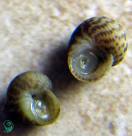Collonista Snails
Taxonomy
Kingdom: Animalia
Phylum: Mollusca
Class: Gastropoda
Order: Archaeogastropoda
Family: Turbinidae
Genus: Collonista
Collonista amakusaensis, the Amakusaensis snail,is not listed in CITES or on the IUCN Red List of Threatened Species.
Small snails of the genus Collonista are commonly referred to as mini-turbos or mini turbo snails, since they are smaller than most other well-known snails of the family Turbinidae.
Geographical range, habitat and habits
The Amakusaensis snail is chiefly nocturnal.
Size and appearance
Collonista amakusaensis can reach a size of 6 mm / 1/4 in, but many specimens stay smaller than 3 mm / 1/8 in even as adults.
The colouration is highly variable; some specimens are uniformly coloured while others display combinations of white, pink, tan, and/or brown. Mottled colour patterns are common.
This mini-turbo can be recognized on its diminutive size and the presence of a small pit or hole in the centre of the calcareous operculum that plugs the shell opening.
Collonista amakusaensis care
Collonista amakusaensis is seldom offered by aquarium shops, but is relatively common in marine aquariums since it arrives as a stowaway with live rock and live sand. Many aquarists erroneously believe that these tiny snails are the offspring of larger snails in the aquarium. Amakusaensis snails can live on all sorts of surfaces in the aquarium, from sand and rockworks to glass, plastic and coral.
Collonista amakusaensis feeds on algae and is considered reef safe. It is peaceful and very small and can therefore be combined with virtually anything. Amakusaensis snails readily breed in aquaria and you may eventually get quite a crowd unless you also keep species that feed on these snails. In a crowded aquarium, you may experience problems with water intakes due to “snail-blockage”. Many aquarists do however report having Amakusaensis snails for years and years in their tanks without experiencing any trouble.
Feeding Collonista amakusaensis
Collonista amakusaensis feed on algae, especially film algae. They are small but can be used as efficient algae-removers since the readily reproduce in captivity.
Breeding Collonista amakusaensis
As mentioned above, this snail happily breeds in captivity – a fact which distinguishes it from most other broadcast spawners. The reason behind the comparatively high survival rate of the offspring is believed to be an unusually short planktonic/pelagic stage.

